
* In the years following World War II, the helicopter came of age, being put to practical use in commerce and on the battlefield. The first generation of operational helicopters were small and had limited payload capacity; by the end of the decade, a second generation that included more capable machines had emerged, with Sikorsky introducing the "S-55" or "H-19". In the mid-1950s Sikorsky followed the S-55 with the giant "S-56" or "H-37"; and a more impressive follow-on to the S-55 in the form of the "S-58" or "H-34", which proved particularly popular. This document provides a history and description of the S-55, S-56, and S-58. A list of illustration credits is included at the end.
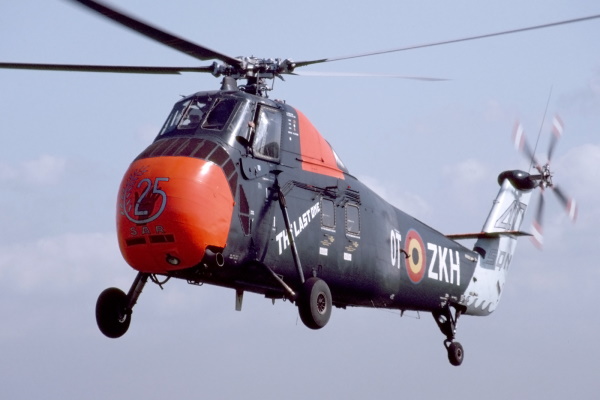
* Sikorsky's early helicopters, such as the R-4, R-6, S-51, and S-52, were modest aircraft, with limited load-carrying capacity and performance. In early 1949, the US Air Force wanted something more formidable for an Arctic rescue helicopter, and in response Sikorsky came up with a design for a large rotorcraft with the company designation of "S-55". The USAF liked the proposal and ordered 5 "YH-19" machines for evaluation, the first flying on 10 November 1949. The evaluation proved satisfactory and the Air Force ordered a batch of 55 "H-19A" production machines, given the name "Chickasaw" in honor of an American native tribe. Initial service deliveries were in 1950.
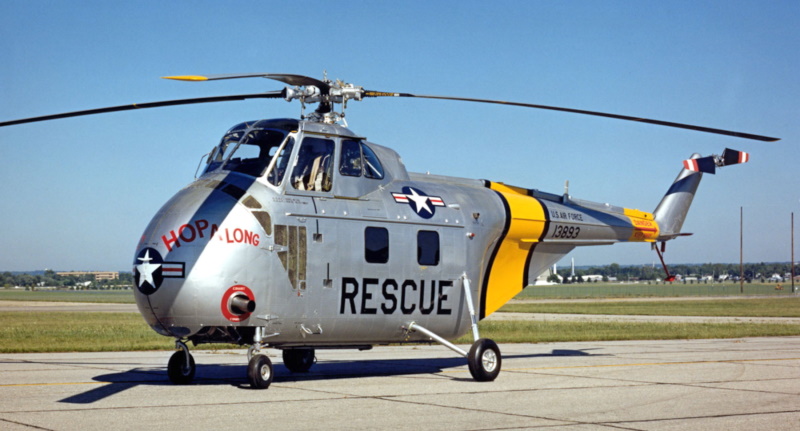
The S-55 was a ten-seat helicopter of classic main-tail rotor configuration, with the pilot and copilot sitting in a cockpit above a relatively roomy passenger cabin, and a wide sliding passenger door on the right. Dual controls were standard. The main rotors had three blades and the tail rotor had two blades, with the rotors of metal construction. Blade life was much longer than in earlier helicopters.
The tail rotor was fitted on a slender boom, which was reinforced by a triangular fillet connected to the rear of the passenger cabin -- the fillet wasn't fitted in the original prototypes. The tailboom was tilted down three degrees; it had been straight in prototype development, but that led to strikes by the main rotor blades, the blade tips tending to bounce down when the helicopter settled to the ground. There were tailfins in an inverted vee configuration under the tailboom, and a strut at the end of the boom to protect the tail rotor from ground strikes.
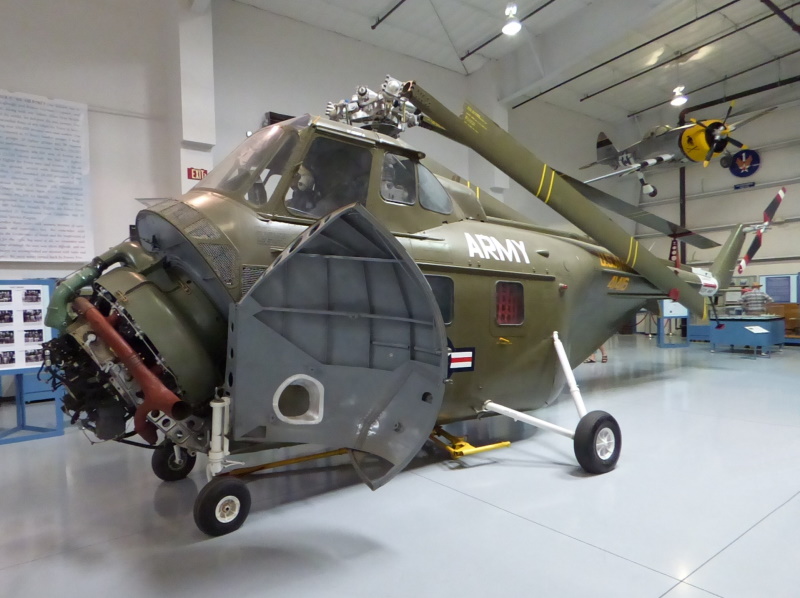
The machine was powered by a Pratt & Whitney (P&W) R-1340-57 Wasp air-cooled 9-cylinder radial engine with 445 kW (600 HP), mounted on a tilt in the nose behind clamshell service doors, and with the driveshaft running up through the cabin below and between the pilot and copilot. This somewhat unusual arrangement made the S-55 relatively insensitive to load trim, which had been a problem with Sikorsky's earlier helicopters, and also simplified service access to the engine -- though apparently it also made for an extremely noisy cockpit. There was a distinctive row of air inlets for a cooling fan directly in front of the cockpit windscreen.
___________________________________________________________________
SIKORSKY S-55:
___________________________________________________________________
main rotor diameter:
16.16 meters (53 feet)
tail rotor diameter:
2.5 meters (8 feet 2 inches)
fuselage length:
19.1 meters (62 feet 7 inches)
height (rotor head):
4.07 meters (13 feet 4 inches)
empty weight:
2,175 kilograms (13 pounds 4 inches)
max loaded weight:
3,585 kilograms (7,900 pounds)
maximum speed:
160 KPH (100 MPH / 85 KT)
service ceiling:
3,200 meters (10,500 feet)
range:
650 kilometers (405 MI / 350 NMI)
___________________________________________________________________
The S-55 had two crash-resistant fuel tanks under the floor, with a total capacity of 700 liters (185 US gallons). There were two windows on each side of the cargo bay, with a door that slid open to the rear on the right. The S-55 had four-wheel quadricycle landing gear with shock absorbers, with the forward wheels directly beneath the nose and the rear wheels set out to the sides on a triangular strut arrangement. Pontoons with auxiliary wheels could also be fitted, though that appears to have been an unusual configuration.
BACK_TO_TOP* Following the US Army H-19A, the US military obtained a number of improved variants of the S-55:
The list below summarizes S-55 variants obtained by the US military, with Wasp or Cyclone engines:
* The S-55 was quickly rendered obsolete by an improved generation of turbine-powered rotorcraft, but it was sturdy and reliable, if homely in appearance. The S-55 saw limited service in the Vietnam War, and lingered in US military inventory to the late 1960s.
Back in the mid-1960s, Orlando Helicopter Airways (OHA) of Sanford, Florida, obtained rights to the S-55 and promoted a number of variants, including a "Heli-Camper" with living facilities; a "Nite-Writer" with an array of lights for advertising; and a "Bearcat" heavy-duty crop-sprayer. It is unclear how successful OHA was with this business, though the US Army did obtain a number of S-55s "dummied up" to resemble Soviet Mil Mi-24 "Hind" gunships for training purposes. The "QS-55" gunship lookalikes were surprisingly convincing, given the drastic differences between the S-55 and the "Hind". They were eventually phased out when the Army obtained its own Mi-24s.
In 1971, a company named Aviation Specialties obtained certification for a turboshaft conversion of the S-55 designated the "S-55T", with the machine powered by a single Garrett AiResearch (later Allied Signal) TSE331 turboshaft; the refit cut the helicopter's empty weight by about 410 kilograms (900 pounds). The S-55T retained the original Sikorsky rotor system. Aviation Specialties performed about 40 S-55T turbo conversions. OHA also performed turboshaft conversions, even promoting a turbo-powered "Defender" gunship, though it doesn't seem anyone bought off on it.
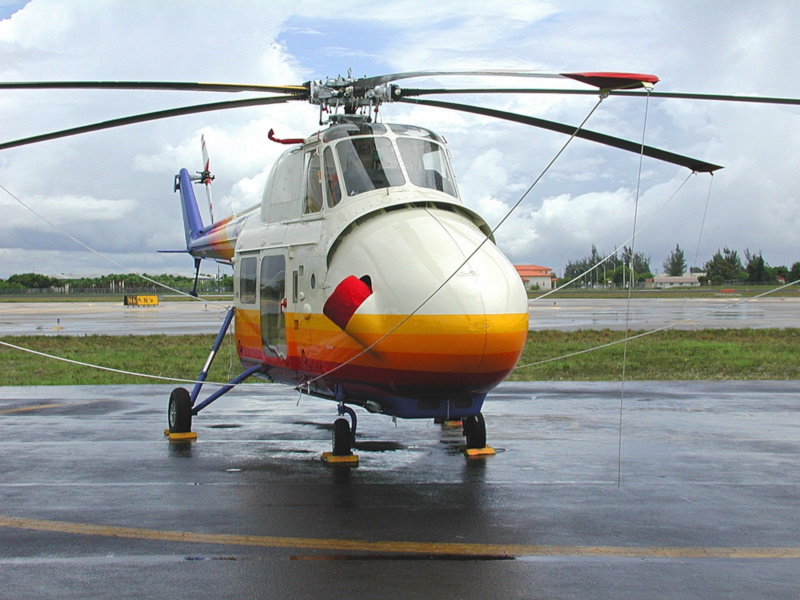
Much later, another company named Vertical Aviation Technologies performed a "quiet" turboshaft conversion of the S-55 designated the "S-55QT", which was certified in 1999. It also featured the Allied Signal TSE331 engine but featured a "quiet" five-bladed main rotor; it was intended for sightseeing, with doors on both sides and large windows and various passenger comforts. The first buyer was a Grand Canyon tour operator.
BACK_TO_TOP* The S-55 was operated by armed forces and commercial operators of over 30 nations. License production was performed by Mitsubishi in Japan -- with 44 built -- and SNCASE in France, the French nicknaming the type the "Joyeux Elephant (Merry Elephant)". However, the most enthusiastic foreign builder was Westland of the UK, producing it as the "Whirlwind". The name was recycled from an unsuccessful twin-engine fighter built by Westland during World War II.
Initially, in 1950 the British Royal Navy obtained from Sikorsky 10 S-55s with the P&W R-1340-40 Wasp radial engine for use in the SAR role -- with these machines designated "Whirlwind HAR.21" -- and 15 S-55s with the more powerful Wright R-1300-3 engine for use in the ASW role -- these machines designated "Whirlwind HAS.22". In the meantime, Westland was negotiating with Sikorsky for license construction, with a deal signed late in of 1950. The agreement was soon expanded to permit Westland to develop their own variants and sell them internationally.
The first British-made Whirlwind performed its initial flight on 15 August 1953, this machine between powered by the R-1340-40 Wasp radial. It led to production deliveries of the "Whirlwind HAR.1" and the similar "Whirlwind HAR.2" to the Royal Air Force (RAF). The HAR.2 led to the "Whirlwind HAR.4" for the RAF -- much like the HAR.2, but with a P&W R-1340-57 Wasp radial engine, it seems with the same baseline performance as the R-1340-40 but with improved "hot-&-high" capability for operations in Malaya. The "HAR.3" was a Royal Navy variant with the Wright R-1300-3 engine. These military variants were paralleled by the civil "WS-55 Whirlwind Series 1" variant, which could be ordered with either the Wasp or Cyclone powerplant.
Westland then went on to make the Whirlwind more distinctly British by fitting it with a 14-cylinder two-row air-cooled Alvis Leonides Major Mark 155 or Mark 755 engine, derated to 560 kW (750 HP). The Royal Navy obtained three "Whirlwind HAR.5" machines with the Leonides Major engine, with Austria obtaining five; the Royal Navy then went on to obtain a larger batch of "Whirlwind HAS.7" machines with the same powerplant for the ASW role. Two VIP transport subvariants were obtained by the Queen's Flight under the designation of "Whirlwind HCC.8", while Westland sold a civil subvariant with the Leonides Major engine as the "Whirlwind Series 2".
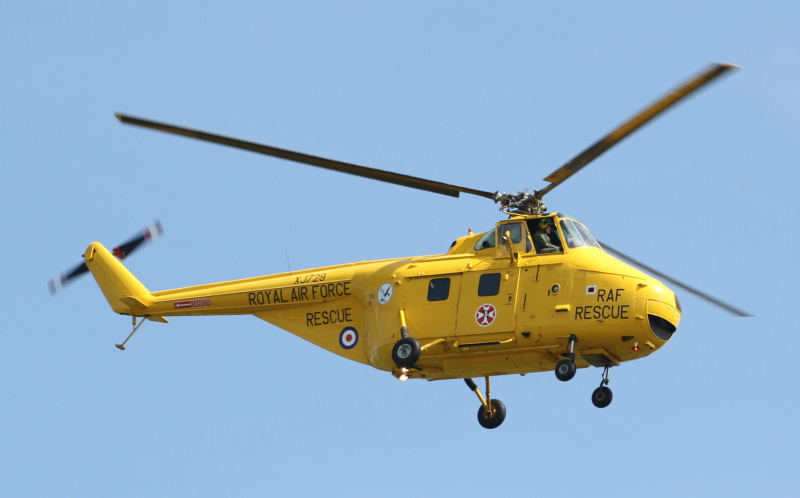
* In September 1959, Westland flew a Whirlwind with a Bristol-Siddeley (later Rolls-Royce) Gnome H.1000 turboshaft engine with 785 kW (1,050 SHP) in place of the radial piston engine -- the Gnome being a license-built version of the US General Electric T58 turboshaft. The Royal Navy updated a number of HAS.7 machines with the Gnome H.1000 engine, with these machines designated "Whirlwind HAR.9". The RAF obtained a similarly powered "Whirlwind HAR.10" variant, mostly by new production but with some updates from HAR.2 and HAR.4 airframes. The Queen's Flight obtained two "Whirlwind HCC.12" VIP machines with the Gnome H.1400 engine; Westland also sold a civil "Whirlwind Series 3" with the Gnome H.1000. The list below summarizes Whirlwind variants, with Wasp, Cyclone, Leonides Major, or Gnome engines:
Along with Britain, well over a dozen countries obtained new-build or hand-me-down Whirlwinds. A fair number are on static display; it is unclear if any remain in flying condition.
BACK_TO_TOP* In 1950, the US Marine Corps had awarded a contract to Sikorsky to develop an even bigger helicopter to carry troops, vehicles, and supplies into combat. The result was the "S-56", with the first of four prototypes, designated the "XHR2S-1", performing its initial flight on 18 December 1953. Successful evaluation of the type led to orders from the US Marine Corps for the production "HR2S-1" -- later "CH-37C". The first production machine performed its initial flight on 25 October 1955, and service deliveries began in 1956. The Marines obtained a total of 55 HR2S-1 machines.
The S-56 was Sikorsky's first "giant" helicopter, and first twin-engine
helicopter. It was of more or less conventional main-tail rotor
configuration, with a five-blade main rotor and a four-blade tail rotor. The
main rotor could be folded by a hydraulic system, an innovation at the time.
The S-56 was powered by two P&W R-2800-54 Twin Wasp two-row radial engines,
each providing 1,415 kW (1,900 HP) and enclosed in pods or "power eggs"
mounted on each side of the whale-sized fuselage; later production featured
R-2800-54 engines with 1,565 kW (2,100 HP) each. The engine arrangement
simplified service access and left the cabin unobstructed.
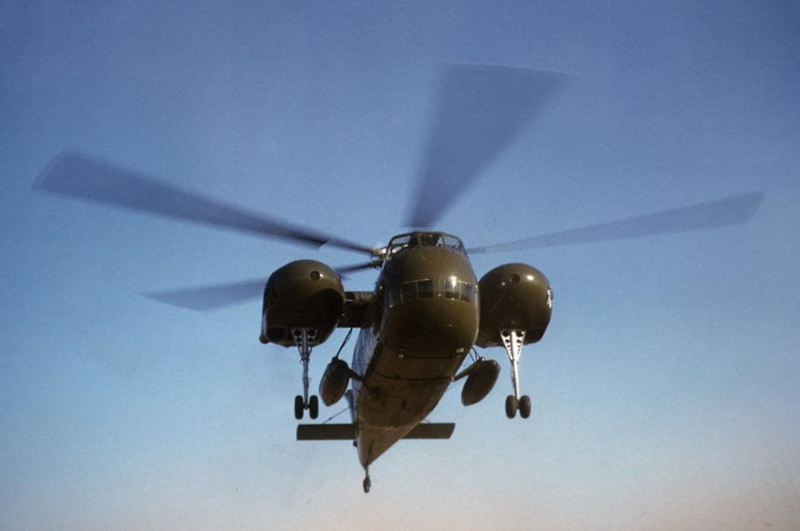
The cabin had a volume of 53.8 cubic meters (1,900 cubic feet), could be loaded through clamshell doors in the nose beneath the cockpit, and had a cargo hoist in the ceiling with a load capacity of 900 kilograms (2,000 pounds). Along with two or three crew, up to 26 troops could be carried; alternate loads included 24 stretcher cases with a medical attendant, or three jeeps -- which could drive directly into the helicopter on a ramp through the clamshell nose doors. It could also carry external sling loads. There was a large sliding door on the right rear fuselage.
The S-56 had tailwheel landing gear configuration, with fixed single-wheel tail gear and long twin-wheel main gear that retracted back into the engine nacelles. It could carry an external tank on an attachment on each side of the fuselage.
___________________________________________________________________
SIKORSKY S-56 (HR2S-1 / H-37A):
___________________________________________________________________
main rotor diameter:
21.95 meters (72 feet)
tail rotor diameter:
4.57 meters (15 feet)
fuselage length:
19.76 meters (64 feet 10 inches)
height:
6.71 meters (22 feet)
empty weight:
9,385 kilograms (20,690 pounds)
normal take-off weight:
14,060 kilograms (31,000 pounds)
maximum speed:
210 KPH (130 MPH / 115 KT)
service ceiling:
2,650 meters (8,700 feet)
hover ceiling (out of ground effect):
335 meters (1,100 feet)
range:
235 kilometers (145 MI / 125 NMI)
___________________________________________________________________
Two USMC HR2S-1s were modified as airborne early warning platforms, with a radome under the nose accommodating an AN/APS-20E search radar and an enlarged crew including radar operators. These two machines were given the new designation of "HR2S-1W", but the variant was not adopted for service.
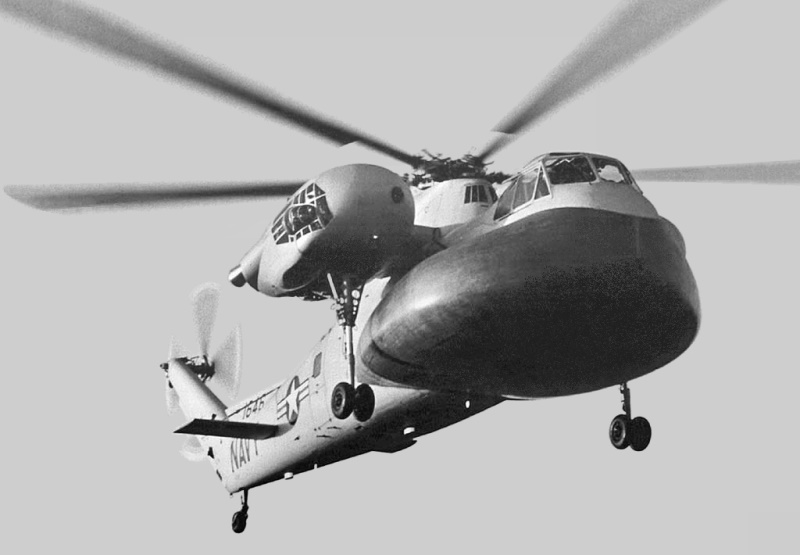
One pre-production HR2S-1 was transferred to the US Army in 1954 for evaluation as the "YH-37". The Army was sufficiently impressed by the machine to order 94 similar machines under the designation of "H-37A Mojave" (later "CH-37A"), going into service in 1958. Final deliveries of this variant were in May 1960; 90 of them were then updated up to the end of 1962 to the "H-37B" ("CH-37B") standard, which featured an autostabilization system to allow it to be loaded or unloaded while in hover.
The S-56 saw service early in the Vietnam War, being used to recover downed aircraft, helicopters, and other gear. The S-56 seems to have been well-regarded, but it was pushing the limits on what could be reasonably done with a piston-powered helicopter -- being expensive to operate and not nearly as effective as a modern turboshaft-powered helicopter of the same size. Marines called it the "Deuce" for its HR2S designation, though it was also nicknamed the "cross-eyed monster"; the front of the engine pods was often painted white, with an intake on the front of each pod giving the machine its "cross-eyed" appearance. Sometimes crews enhanced the "eyes" with imaginative painting, or had the "eyes" painted on their flight helmets to advertise their mount.
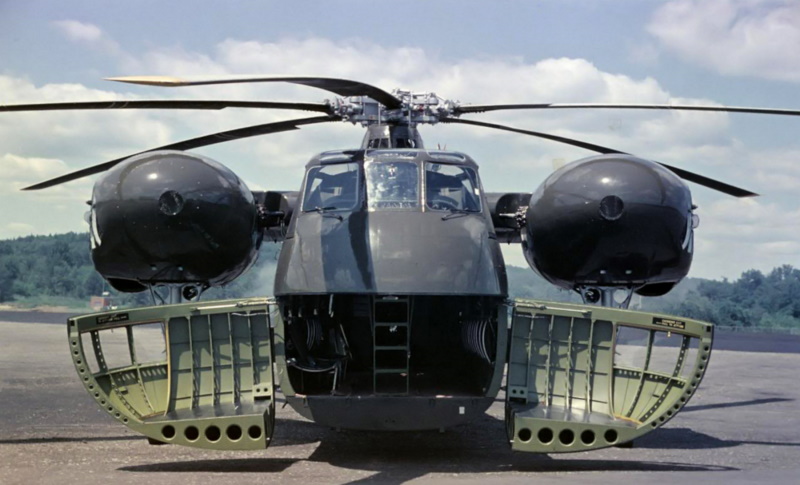
The original prototype was experimentally modified with twin tail rotors, and an Army CH-37A was fitted with a six-blade rotor for trials. The same power system was used in the "S-60 Skycrane" demonstrator, which led to the turbine-powered "S-64 Skycrane". Westland attempted to build a helicopter named the "Westminster" that used the S-56 dynamic system, but had a new fuselage and twin Napier Eland turboshafts -- but it was never completed.
* In its day, the S-56 was one of and the biggest and fastest helicopters built in the West. Only 153 were built, including the prototype, and it was never exported; a photo survives of an S-56 in civilian colors, but details are unclear. The major historical importance of the S-56 was that it led to the modern Sikorsky giant series of helicopters -- the S-61, S-64, and S-65. The last S-56s were retired in the late 1960s. A number survive on static display, but none remain flightworthy.
BACK_TO_TOP* While users were generally pleased with the S-55, the US Navy wanted a machine with more payload and range for the ASW mission. A competition for such an improved machine was initiated in 1952, even though the S-55 had only recently entered Navy service. Bell and Sikorsky flew prototypes in competition for the contract.
The Bell machine was the "HSL-1", which was a twin-rotor design roughly along the lines of the Piasecki H-21 "Flying Banana". The HSL-1 proved notably unsuccessful, with the nod going to Sikorsky for the "S-58", a follow-on design to the S-55, a contract for four prototypes being awarded on 30 June 1952. First flight of the initial prototype, with the Navy designation of "XHSS-1", was on 8 March 1954, with the first production Navy "HSS-1 Seabat" -- later "SH-34G" -- flying for the first time on 20 September 1954, and introduction to service in August 1955.
The S-58 only looked like the S-55 from the cockpit forward, having inherited the engine arrangement -- a Wright R-1820 Cyclone radial engine in the nose, driving the rotor system via a crankshaft up through the cockpit. Additional soundproofing was fitted to reduce the high cockpit noise levels suffered with the S-55. The S-58 was otherwise almost completely redesigned, featuring a fuselage with a low tailboom and tailwheel landing gear. Instead of the three-blade main rotor and two-blade tail rotor of the S-55, the S-58 had four-blade main and tail rotors. As with the S-55, the S-58 featured two aircrew in an upper cockpit, with a rear-sliding door on the right side of the payload bay.
___________________________________________________________________
SIKORSKY S-58:
___________________________________________________________________
main rotor diameter:
17.07 meters (56 feet)
tail rotor diameter:
2.9 meters (9 feet 6 inches)
fuselage length:
14.25 meters (46 feet 9 inches)
footprint length:
17.27 meters (56 feet 7 inches)
height (rotor head):
4.85 meters (15 feet 10 inches)
empty weight:
3,460 kilograms (7,630 pounds)
max loaded weight:
5,900 kilograms (13,000 pounds)
maximum speed:
200 KPH (125 MPH / 105 KT)
service ceiling:
2,895 meters (9,500 feet)
hover ceiling (in ground effect):
1,495 meters (4,900 feet)
hover ceiling (out of ground effect):
730 meters (2,400 feet)
range:
290 kilometers (180 MI / 155 NMI)
___________________________________________________________________
The main rotors could fold, and the tail could be hinged forward for shipboard stowage. Although it doesn't appear any S-58s were fitted with pontoons, the landing gear arrangement not being particularly convenient for fitting them, inflatable flotation gear could be fitted, with an inflation pack under the rear fuselage or around the tailwheel, plus a pack on each main landing gear assembly. The main landing gear assemblies had two configurations, one with the pack fitted to the wheel hub, the other in the form of a "donut" around the wheel.
The HSS-1 could carry an AN/AQS-4 or -5 dipping sonar, with a well in the floor for the dipping sonar head. It could also carry a homing torpedo or depth charge on each side of the fuselage; another possible S-58 external store was a 568-liter (150 US gallon) external tank, though it is unclear if early S-58 variants like the HSS-1 were capable of using the external tanks. S-58 variants for utility use could carry from 12 to 18 passengers, depending on variant, or six litters and a medical attendant. Sling loads of up to 2,265 kilograms (5,000 pounds) could be hauled externally.
BACK_TO_TOP* As with the S-55, the S-58 was produced in a range of variants:
The Marine HUS-1 machines saw considerable combat service in Vietnam from 1962 to 1964. They were often armed, initially with a Browning 7.62-millimeter (0.30-caliber) machine gun on a flexible door mount or window mount, the Browning being later replaced by the lighter 7.62-millimeter M60 machine gun. Armor was eventually added to protect the engine and crew. Experiments were performed with S-58s carrying external cannon pods, unguided rocket pods, and even Bullpup radio-guided missiles, but the S-58 saw little or no use in Vietnam as a gunship.
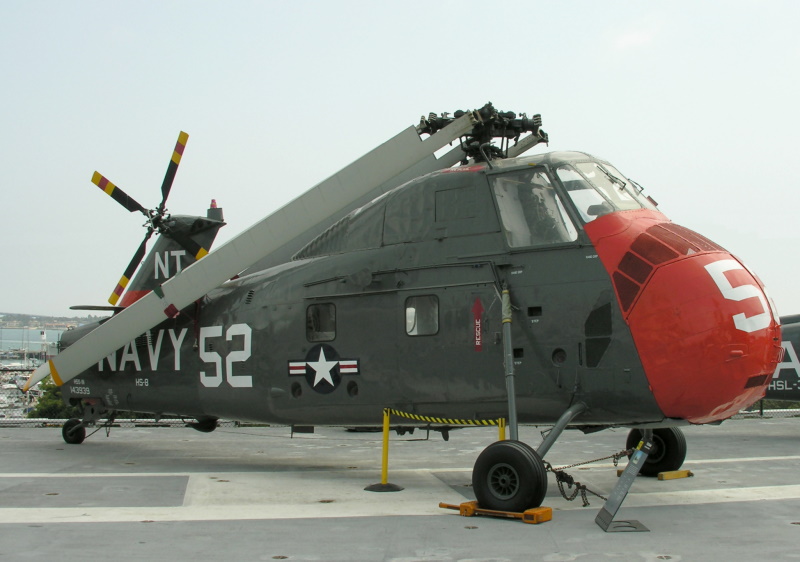
The list below summarizes S-58 variants obtained by the US military:
* Sikorsky built a total of 1,820 S-58 machines up to end of production in January 1970. A number of military S-58s ended up in civilian hands after their retirement from service.
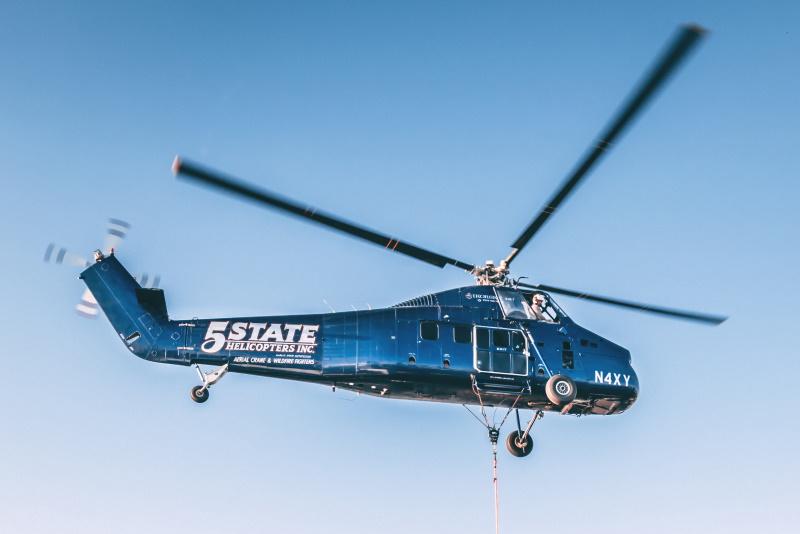
Although a prototype of a turboshaft-powered S-58, the "HSS-1F" ("SH-34H"), was flown in 1957 -- being powered by twin General Electric (GE) T58 engines -- Sikorsky never produced an S-58 variant with turbine power. However, in 1971 the company received FAA certification for an "S-58T" conversion with a Pratt & Whitney Canada PT6A twinpac turboshaft engine system.
One of the most unusual modifications of the S-58 was performed by the Piasecki company, which took four surplus UH-34Js, chopped off the tails, joined them together in a 2x2 arrangement using a metal framework, with the framework hung from a blimp envelope. The idea of the Piasecki "Heli-Stat" was to haul logs or other large sling payloads, but the idea was a deadly bust: the machine suffered from "ground resonance", with the backwash from the rotors onto the ground washing back up against the blimp envelope, and the Heli-Stat disastrously broke up in a test, one of the pilots being killed, the entire ghastly incident being caught on film.
BACK_TO_TOP* The S-58 was widely exported, being used by most or all NATO nations, as well as built under license by Sud-Est in France, with Westland of the UK building it in a turboshaft-powered variant, named the "Wessex".
Westland obtained a single S-58 from Sikorsky as a prelude to license manufacture. The British company had no interest in a piston-powered variant, using the sample machine to evaluate installation of a Napier Gazelle NGa.11 turboshaft with 820 kW (1,100 SHP), the re-engined machine flying for the first time in its new configuration on 27 May 1957. The demonstrator led to a prototype and two pre-production examples of the "Wessex HAS.1" for the Royal Navy, powered by the Gazelle Mk.161 with 1,080 kW (1,450 SHP).
Aside from the turbine installation in an extended nose, the Wessex was much the same as a piston-powered S-58. All Wessex machines had the two-strut main landing gear. The Royal Navy obtained about 130 HAS.1 machines for use in the ASW role and, in Royal Marine service, assault transports. In ASW operation, one Wessex would operate as a "hunter" with dipping sonar, while the other would operate as a "killer", carrying two homing torpedoes or depth charges.
In assault transport configuration, the HAS.1 was able to carry 16 troops, 8 stretchers, 1,815 kilograms (4,000 pounds) of internal cargo, or a similar load carried on an external sling. Armament configurations for battlefield operations included a door-mounted light machine gun, plus four SS-11 or SS-12 wire-guided missiles on external mounts, four unguided rocket packs, or two wire-guided missiles and two unguided rocket packs. Royal Navy Wessex helicopters were often fitted with inflatable flotation gear.
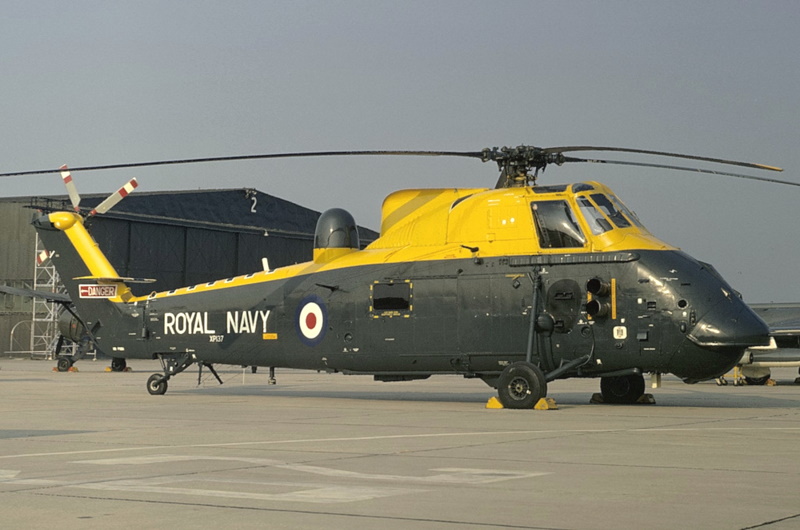
The Royal Australian Navy obtained 27 "Wessex HAS.31" machines much like the HAS.1, but with a Gazelle NGa.13/2 engine providing 1,150 kW (1,540 SHP). They were later updated to "HAS.31B" configuration with improved ASW gear and other updated kit. The HAS.1 was followed in Royal Navy service by the "Wessex HAS.3", which featured the uprated Gazelle NGa.22 engine, and in particular an advanced automatic flight control system. It also had a MEL.391 search radar in a radome on the back, and was accordingly nicknamed the "Camel".
The Royal Air Force also obtained the Wessex from 1962, beginning with the "Wessex HC.2" utility machine. It differed from the HAS.1 most significantly in being powered by dual Gnome (T58) turboshafts. Each Gnome provided 1,010 kW (1,350 SHP); the two engines of course drove a common gearbox, with one engine able to take up the load if the other failed. The engines were "handed", with a Mark 110 and Mark 111 ganged together. It appears that Gazelle-powered machines had dual exhausts on both sides of the nose; Gnome-powered machines had a single, larger exhaust on both sides of the nose.
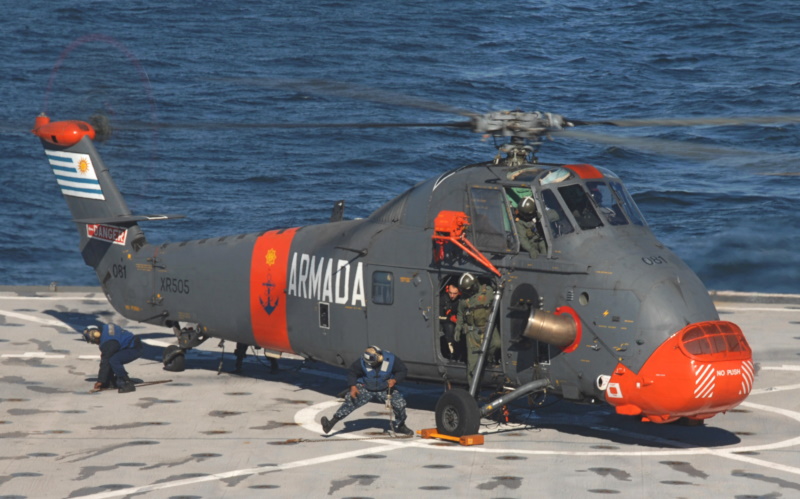
The RAF later obtained an "HC.5" for SAR duties, with improved Mark 112/113 engines; the Royal Marines obtained a similar "HU.5" as an assault transport. Two similar VIP transports designated "Wessex HCC.4" were built for the Queen's Flight, operating from 1969. Iraq obtained 12 HC.2-type machines designated "Wessex Mk.52", while Ghana obtained 3 "Wessex Mk.53" machines and Brunei obtained 1 "Wessex Mk.54" machine. A civil version of the HC.2, the "Wessex Mk.60", was sold as well, with nine sold to Bristol helicopters and the Uruguayan Navy obtaining a number of them; it appears the Uruguayan Navy also obtained a number of hand-me-down RAF HC.2 machines.
The list below summarizes Wessex variants, with Gazelle or twin Gnome engines:
Total production of the Wessex is given as 356 machines. The Wessex saw considerable combat service, one of its first operations being the British counter-insurgency operation in Malaysia in the early 1960s. The Wessex also performed significant duty in the 1981 Falklands War, with a HAS.3 disabling the Argentine submarine SANTA FE with depth charges and machine-gun fire. The Wessex lingered in UK military service into the early 1990s; some may continue to fly in civilian hands.
BACK_TO_TOP* I chose to use the basic Army designations and names as the "default" service labels for these Sikorsky machines. I did this simply for the sake of simplicity; no slight was intended towards designations and names used by the other US armed services.
* Sources include:
As always, helicopters are under-documented, so I ended up canvassing the internet for details, and also finding some materials in older editions of JANE'S ALL THE WORLD'S AIRCRAFT. I wasn't able to find as much about the operational history of any of these machines as I would have liked, and was unable to find any really solid sources on the S-55. I would regard production quantities cited here as not entirely reliable, if still in the ballpark.
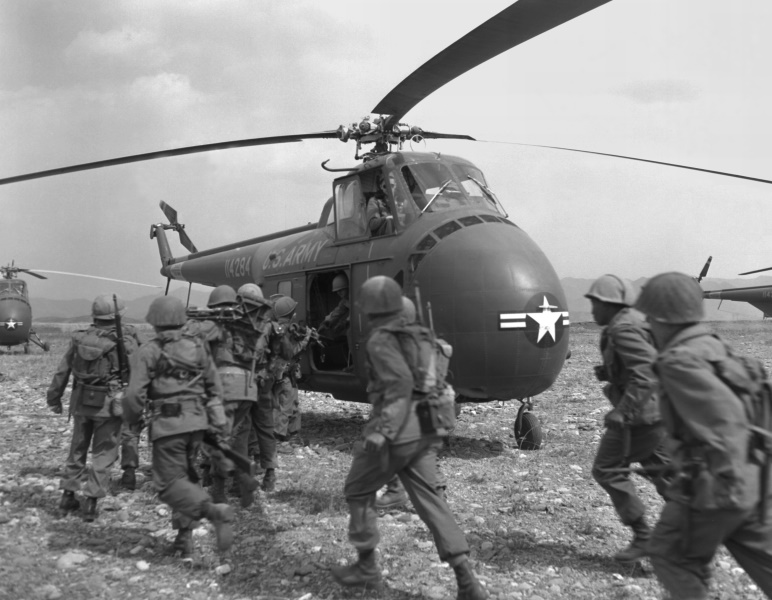
* Illustrations credits:
* Revision history:
v1.0.0 / 01 feb 11 v1.0.1 / 01 jan 13 / Review & polish. v1.1.0 / 01 oct 14 / Considerable cleanup. v1.1.1 / 01 sep 16 / Review & polish. v1.1.2 / 01 aug 18 / Review & polish. v1.2.0 / 01 jul 20 / Review & polish, illustrations update. v1.2.1 / 01 may 22 / Review & polish. v1.2.2 / 01 apr 24 / Review & polish. (+)BACK_TO_TOP
